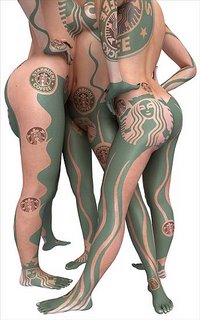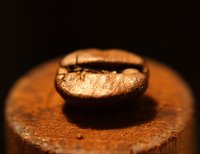
I am re-posting this very controversial article originally published on "Seeking Alpha" on December 27, 2006. I think this is one of the better articles on this subject. I particularly like the balanced perspective acheived through the posted comments adjoining the article.
David Phillips (10Q Detective) submits: Oxfam, a development charity that dates back to World War II, alleges that global coffee retailer Starbucks Corp. (SBUX) is depriving Ethiopian coffee farmers of between $88.0 to $132.0 million a year, by opposing the Ethiopian government's efforts to trademark three popular varieties of its specialty coffee—Harar, Sidamo and Yirgacheffe beans.
Oxfam and its broad coalition of supporters say:
More than a year ago, Ethiopia approached Starbucks and asked the company to lead the coffee industry by example and sign an agreement recognizing Ethiopia's legal ownership of its fine coffee names. If companies like Starbucks signed such agreements, Ethiopia would occupy a stronger negotiating position with foreign buyers, capture a larger share of the market associated with its coffee names, and better protect its brands.
Oxfam and its activists allege that there is a huge disparity in the profit distribution to the players in the coffee industry, with Ethiopian coffee farmers often collecting no more than 10 percent of the profits from the sale of their coffees. The rest goes to the coffee industry players that can control the retail price—the international importers, distributors, and roasters like Starbucks.
Starbucks CEO Jim Donald met with Ethiopiaian government officials to discuss trademark issues on November 29, 2006. Given little progress in their talks, Oxfam and its supporters organized “The Starbucks Day of Action” in more than a dozen countries, demonstrating outside many Starbucks stores on December 16, with activists leafleting and carrying the image of an Ethiopian coffee farmer on sandwich board fronts, with the backside reading, "For every cup of Ethiopian coffee Starbucks sells, Ethiopian farmer earn 3 cents. Tell Starbucks: Honor your commitments to coffee farmers." [Ed. note. Watch the video on YouTube now.]
Talks purportedly broke down because Starbucks favored a geographic certification model—much like Jamaican Blue Mountain Coffee, Florida Orange Juice, and French and Napa Valley Wines—which guarantees a point of origin and standard of quality; whereas, Ethiopia refused, opting for brand ownership.
We laud Oxfam’s good intentions, but question their grasp of Ethiopia’s calculus for peculations.
The rhetoric behind economic development today—especially in African countries—is such that where poverty exists, you can be sure that “corruption” won’t be far behind. Aside from widespread allegations of fraud following the May 2005 parliamentary elections, in which results showed the incumbent Ethiopian People's Revolutionary Democratic Front retaining a majority, the business environment—while not thought to be as corrupt as political life—in Ethiopia, still ranked only a 3.70 score (with 1.0 being the best & 5.0 being the worst) on an ”Index of Economic Freedom 2006” census taken by The Heritage Foundation/ Wall Street Journal:
Ethiopia's cumbersome bureaucracy deters investment…. Corruption in Ethiopia poses various problems for [the] business environment, as patronage networks are firmly entrenched and political clout is often used to gain economic prowess.
In our view, irrespective of going the certification process or the intellectual property route, in order for the coffee farmers to share in any incremental value—such as an increase in annual income—necessitates a transparent system that shows how the money is going back to the farmers.
In addition to failing to explain what type of transparent ‘checks and balances’ system need be established, nowhere in its press releases does Oxfam explain how the agency derived the incremental annual benefit to farmers of between $88.0 to $132.0 million.
To the contrary, since 2001, Starbucks has been inserting transparency into standard contracts. Today, the Company has economic transparency requirements for 59 percent of all coffee purchased to provide information on the payments made to farmers. This represents 177 million lbs. (80 million kg.) of coffee.
In December 22, 2006, Starbucks' Letter to the Editor of the Seattle Post Intelligencer (regarding the Ethiopian Trademark), Dub Hay, VP-Global Coffee Procurement said, too:
While our purchases of Ethiopian coffee represent a very small percentage of the country’s total coffee exports, we pay premium prices – in 2005 our price exceeded the New York commodity market price by 23 percent -- for all of the coffee we buy in 27 countries. And, between 2002 and 2006 we increased purchases of Ethiopian coffee by more than 400 percent and are committed to growing those purchases in the years to come.
In our view Oxfam and its supporters have not presented a cogent argument to suggest that Starbucks is acting in an unethical or socially irresponsible manner; nor has Oxfam presented any convincing evidence that Starbucks is willfully trying to maximize its own profit margins—by denying Ethiopian farmers their legitimate coffee profits.
Voir dire [Old French: “To speak the truth”] is a tool used to achieve the constitutional right to an impartial jury. Preliminary examination of Oxfam as an impartial juror would show that the aid agency is in an awkward position to comment on the social responsibility of Starbucks:
1. Language found in a Coffee (Rescue Plan) Policy paper [2002] speaks volumes:
Despite the stagnant consumer market, the coffee companies are laughing all the way to the bank…. Until now, rich consumer countries and the huge companies based in them responded to the crises [slump in coffee prices and economic impact on coffee farmers] with inexcusable complacency. In the face of human misery, there have been many words yet little action.
2. In 2004, Oxfam accepted a £100,000 investment by Starbucks into a rural coffee-growing project in Ethiopia and a range of expertise-sharing programs focusing on improving trading agreements for millions of coffee farmers in developing countries.
Given the weaknesses of Oxfam’s arguments and its lapses in credibility, Starbucks comes across less as a coffee-thirsty exploiter of less-developed countries, and more the victim of a coffee mugging.
Editor David J Phillips does not hold financial interests in any of the companies mentioned in this posting. The 10Q Detective has a Full Disclosure policy.
Seeking alpha December 27, 2006
Eugene Clough wrote on Wed Dec 27th @ 3:17 am
Hi,
Let's hear it for Starbucks.
abera mola wrote on Wed Dec 27th @ 8:31 am
Jamaican Blue Mountain Coffee holds a trademark, you can check at uspto.org. Second, it is infact Starbucks' argument that makes no sense. It is completely devoid of economic reasoning and the company has chosen to argue its case by citing aid programs it participated in and sometimes even bordering on patronizing comments stating that the Ethiopians wouldn't know how to handle a trademark. 23% over the the New York commodity market for speciality coffees is a joke ... the New York commodity market prices are for bulk auctioned coffee (eg. the folgers blended brands that you find in grocery stores). The selling prices for the speciality coffees is in some cases between 100% - 500% [in some cases more] of what the folgers brands sell for. All Ethiopia is asking is that the prices its farmers get for the speciality coffees [not all its coffees] reflect these differences. The way it hopes to do that is through trademarking.
A most important element you are overlooking is that these coffee brands are the IPs of Ethiopian farmers not that of Sbux and they have a right to do what they will with it [regardless of Sbux sensitivities] ... plus impartiality would have required that you mention Sbux's attemot to trademark the name Sidamo as part of its application in 2004.
Greg Sherwin wrote on Wed Dec 27th @ 3:04 pm
Ahhhh, the answer is "no"?!?
Fair Trade was devised by people who wanted to counter the price squeeze of coffee farmers at the bottom of the chain while retailers profited handsomely with huge margins. Essentially, Starbucks was one of the reasons why Fair Trade coffee came about. Wisely, they saw the opportunity and co-opted it, and now boast their Fair Tradeness as a badge of honor -- in a little smoke and mirrors to deny their prior practices that lead to its creation. So Starbucks is hardly the victim here.
Same goes for the Oxfam case. While I certainly would question the transparency of Ethiopia and the hands over which revenues would flow in that country, it's a bit disingenous to suggest that Ethiopian growers don't deserve protections we afford other food & drink producers around the world because they happen to be unlucky enough to live under problematic government leadership.
I think the most culpable act that Starbucks did surround this was, first of all, denying that they were behind the National Coffee Associations' veto on the measure. And now they've come back front and center publicly stating they were against Ethiopian certification. Talk about speaking out of both corners of your mouth.
I wouldn't go so far as to suggest that Starbucks is some bloodthirsty exploitation machine, the way that Nike has been portrayed. However, like Disney, they profit handsomely from a Potemkin village of ethical propriety when behind the scenes they are no better -- or worse -- than any other profit-making corporation. So calling Starbucks the victim of a mugging is a bit falling for the bait. You should know better.










